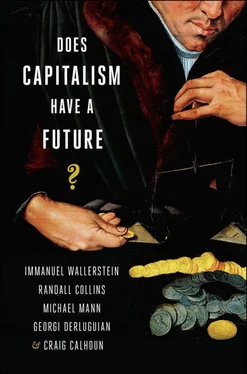Immanuel Wallerstein - Does Capitalism Have a Future?
Здесь есть возможность читать онлайн «Immanuel Wallerstein - Does Capitalism Have a Future?» весь текст электронной книги совершенно бесплатно (целиком полную версию без сокращений). В некоторых случаях можно слушать аудио, скачать через торрент в формате fb2 и присутствует краткое содержание. Город: New York, Год выпуска: 2013, ISBN: 2013, Издательство: Oxford University Press, Жанр: Публицистика, sci_economy, на английском языке. Описание произведения, (предисловие) а так же отзывы посетителей доступны на портале библиотеки ЛибКат.
- Название:Does Capitalism Have a Future?
- Автор:
- Издательство:Oxford University Press
- Жанр:
- Год:2013
- Город:New York
- ISBN:978-0-19-933084-3
- Рейтинг книги:5 / 5. Голосов: 1
-
Избранное:Добавить в избранное
- Отзывы:
-
Ваша оценка:
- 100
- 1
- 2
- 3
- 4
- 5
Does Capitalism Have a Future?: краткое содержание, описание и аннотация
Предлагаем к чтению аннотацию, описание, краткое содержание или предисловие (зависит от того, что написал сам автор книги «Does Capitalism Have a Future?»). Если вы не нашли необходимую информацию о книге — напишите в комментариях, мы постараемся отыскать её.
Does Capitalism Have a Future? — читать онлайн бесплатно полную книгу (весь текст) целиком
Ниже представлен текст книги, разбитый по страницам. Система сохранения места последней прочитанной страницы, позволяет с удобством читать онлайн бесплатно книгу «Does Capitalism Have a Future?», без необходимости каждый раз заново искать на чём Вы остановились. Поставьте закладку, и сможете в любой момент перейти на страницу, на которой закончили чтение.
Интервал:
Закладка:
It is quite possible that the world will weather the global transition without any of these catastrophes occurring. But it is also possible that it will not. A lot will depend on what will be the new political structures and how soon they can emerge. Conceivably such new structures will take the kinds of measures that can reduce, even eliminate, the likelihood of global disasters. Let us be clear, these are not just natural disasters. Famine, pestilence, nuclear terrorism are decidedly political challenges to humanity. That is why we call them imponderables. The search for effective counter-measures means making political choices. One major way in which many people react to these dangers is to pull inward in a heavily protectionist and xenophobic way. We see this tendency already almost everywhere. It means that those who seek a system that is relatively democratic and relatively egalitarian have to work harder at developing political strategies that will counter this trend.
TRANSITIONS
One big thing we all agree on is that in coming decades the familiar configurations of global political economy are bound to change in significant and not immediately evident ways. Politicians, social movements, and media commentators will be at a loss trying to steer through the coming years on the old conventional wisdom. Governments and once dominant business corporations are going to find their levers of power weakened, their well-practiced moves in the political and ideological repertoires useless or presenting ever new problems down the road. The protesters might feel as outraged as ever. But they will be much less sure against whom to protest, what to demand, how to organize, and with whom to ally themselves. Our theoretical knowledge of the past historical transitions will prove only an imperfect adviser. In the years ahead our theories will require considerable corrections and additions. (But isn’t this the nature of scientific knowledge?) In part, this is because many problems and prospects appear unprecedented in human history. In the main, however, we know that major historical transitions occur simultaneously at several different levels. Business as usual becomes impossible in times of transition. American imperial hegemony is visibly faltering, as geopolitical theory has long predicted. Its biggest reserves in the productivity, finances, and political compliance of China and the European Union are running out. A big question is how precipitous or gradual will be the coming decline of the West. Our best hope perhaps is a negotiated (i.e., nondestructive) equalization in the shares of power and wealth between the historical West and the rising rest of the world.
The key point of agreement, to stress it again, is that the future is not preordained in any great detail. Open-ended political struggles will play a crucial role in selecting the routes and collective destinations. Moreover, social science can make a difference in the coming years. Macrohistorical theories warn against disastrous future possibilities. A middle-ground possibility is fragmentation and involution (i.e., continuing along essentially the same lines only in a lessened, crippled, and worse off shape). Here the recent fate of the Soviet Union serves as the nearest example. Still another nasty possibility is a fascist-like dictatorship supported by social movements of aggrieved nationals and reliant on a militaristic and highly invasive police state. Unfortunately, the record of twentieth-century fascism shows that it could produce, at least for a few decades, viable political economies where large groups of people benefit from oppressing other large groups of people. The exceptionally vicious and megalomaniac Nazi regime in Germany perished from the external war, not from internal political transformation or revolution.
Yet the same theories point to a strong possibility of more hopeful pathways through the chaotic years ahead of us. Our hopes derive from the theoretically grounded observation that human responses to the big structural crises in the past tended to build up qualitatively new and more extensive collective powers. This trend developed through periodic collapses and bursts of human inventiveness (though far from always peaceful) that would eventually pave the way for new periods of stabilization and prosperity.
The human race is now facing another such sequence, and this time it is the entire humanity populating the planet. Our late friend and colleague Giovanni Arrighi used to say that systemic problems call for systemic solutions. In his analytical model, the trajectory of historical capitalism went through several cresting waves of spatial expansions and restructurings. [4] Giovanni Arrighi, The Long Twentieth Century: Money, Power and the Origins of Our Times . (Updated edition). (London: Verso, 2010).
European capitalists had originally secured themselves and their enterprise by acquiring their own national states—with the armies, navies, and the taxation machinery that support them—amid the formative chaos of the sixteenth century. In more analytical terms, capitalism obtained its historical breakthrough in the internalization of protection costs. The next wave brought the deepening of capitalism and its tremendous colonial expansion based on the internalization of production costs, or what is commonly known as the British-led industrial revolution of the 1780s–1840s. But that epoch also ushered in multiple crises flowing from the effects of the business cycle, the institutionalization of revolutionary and reform movements, and the competitive geopolitics of industrial imperialism that in 1914 nearly killed capitalism. The American hegemony of the twentieth century helped to tame these crises by adding another layer of complexity: the internalization of transaction costs. The acute need to stabilize the capitalist system against multiple dangers is what after 1945 determined the elaborate and imposing architecture of modern governments, economic corporations, and international organizations.
Logically then, the epochal accomplishment remaining for the twenty-first century is the internalization of the costs of social and environmental reproduction to be achieved at a truly planetary level. Consider a fact that seems too big to enter the usual policy debates. During the last ten thousand years or so the majority of humankind lived in villages. The invention (rather, the repeated inventions) of village community marked a major reorganization in collective human capabilities. It made possible what archeologists call the Neolithic revolution, and thus agrarian societies. The pattern of village life permitted midsized groups of nonrelatives to organize their common affairs in a robust and comprehensive manner. It took care of everything that mattered for social reproduction: division of labor, the traditional regulation of resources, daily life tensions and conflicts, the transmission of culture and skills, the ideological (or even cosmological) rituals of group solidarity, from the highly mystical to the mundane village dance. In sum, village community organized the functional and emotional aspects of the human life cycle from birth to death. And self-organizing villages served as tributary bases for all the subsequent complex societies, from tribal chiefdoms to city-states and empires.
Capitalism originally emerged into what was still a world of villages. The market and geopolitical dynamism of capitalism soon began undermining village communities because the villagers were needed elsewhere as labor, colonists, and soldiers. On their side, the villagers themselves often found it impossible to stay in their poor and constraining rural locales. The causes of village extinction go by many different names such as modernization, urbanization, industrialization, agrarian overpopulation, the spread of literacy, or imperialism and military revolution. The net effect eventually would be the same everywhere—first in the West, next in Japan, the Soviet bloc, and now all over—draining the countryside of its once numerous inhabitants and moving them into the cities or, even more commonly, into the slums.
Читать дальшеИнтервал:
Закладка:
Похожие книги на «Does Capitalism Have a Future?»
Представляем Вашему вниманию похожие книги на «Does Capitalism Have a Future?» списком для выбора. Мы отобрали схожую по названию и смыслу литературу в надежде предоставить читателям больше вариантов отыскать новые, интересные, ещё непрочитанные произведения.
Обсуждение, отзывы о книге «Does Capitalism Have a Future?» и просто собственные мнения читателей. Оставьте ваши комментарии, напишите, что Вы думаете о произведении, его смысле или главных героях. Укажите что конкретно понравилось, а что нет, и почему Вы так считаете.












